While you might be familiar with the art market, become acquainted with the digital market. Exclusive opportunities might soon arise from this not yet fully matured market.
A Brief History of Art
Paintings, storytelling, dancing and art date back to prehistoric times, preceding writing. These used to be our prime mediums of communication, some dating back to 40,000 years ago.
The oldest art we know of was painted on cave walls or sculpted. Most of these drawings depicted people hunting and fighting in battles. They usually could not be moved, and one had to travel to observe them. Today on the other hand, with the help of the internet and creative tools, an art object becomes something very personal yet at the same time very sharable.
After a while, we started to adopt language and write things down, this is where the “history” of art began because we now had records of not only what was happening historically but we also had a clearer description of the artwork being produced. This happened mostly in Egypt, Persia, Greece, Rome, India and China. This period is known for beautifully crafted pots, decorated with war scenes, gods, and other significant elements of the divine and daily life.
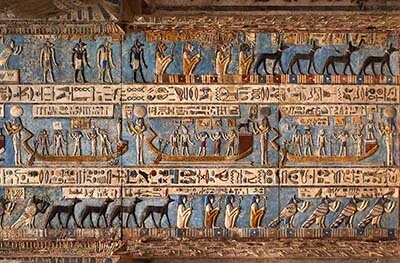 Hieroglyphic carvings and paintings in an ancient Egyptian temple in Dendera
Hieroglyphic carvings and paintings in an ancient Egyptian temple in Dendera
Then came the medieval times, which mostly depicted religious works of art in churches, on icons and in the bible. Religion was at the center of everything and there was very little freedom for artists.
The Renaissance era brought perspective, which was increasingly important in works of art and paintings became much more detailed.
Then came what we know of today as modern art. This was the period of Vann Gogh and his famous “Scream” painting. Along with modern art, came all the “isms”: Impressionism, Expressionism, Cubism, Dadaism, and Surrealism. This type of art was heavily affected by out-of-the-box thinking. Artists were no longer confined in having to paint the divine, and good, giving full freedom to their thoughts and imagination. These were times of Sigmund Freud and Einstein, which were among some of the catalysts to opening the minds of people to something stimulating and completely new.
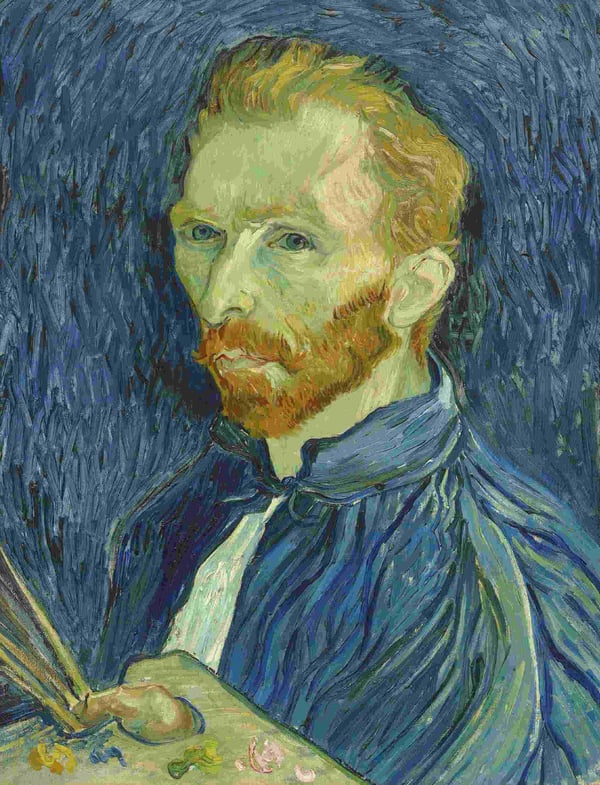 Self Portrait, Van Gogh (1889)
Self Portrait, Van Gogh (1889)
As soon as technology and computers entered the art scene, works of art exploded. One may argue that this showed our true need for creativity, whether it is graffiti, one of Vann Gogh’s masterpieces or something completely different like Andy Warhol’s Campbell soup cans.
Another pivotal and very important aspect to understand when speaking of digital art is that it is not limited to the creation of new art. In other words, the self portrait of Van Gogh, seen above, may be used in today’s digital art. It can be incorporated into a digital work of art, as can any other painting, drawing or even statue created by artists from previous eras. Below is an example of this: Leonardo da Vinci’s Mona Lisa portrayed in a “psychedelic style”.
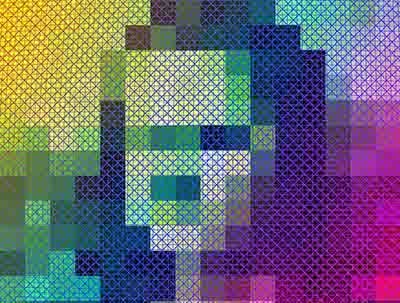 Psychedelic woman portrait. Pixel art by Robin Ph.
Psychedelic woman portrait. Pixel art by Robin Ph.
What is Digital art?
Digital art is art made in a digital world. As technology advances, so does digital art. For example, a blogger in Switzerland can produce and share his or her art almost instantaneously with the whole world, increasing the visibility of their content immensely. With the consent of the author, this content may be commented on, altered, “improved on” or even transformed completely, meaning that digital art is ever evolving as well as becoming a social or interactive object.
An important concept to understand about digital art is that the “object” can be a digital, physical, social or/and an interactive object.
Digital, visible art is any type of visible art which you can see on a screen or in printed form. Physical digital art - art with which you can physically interact. The best experiences with interactive art are usually ones in digital art galleries. Social object - This is where social media comes in. Nowadays, digital art may not only be shared worldwide but also commented on, criticized, discussed and so on. Interactive Digital object - digital art with which you can interact with physically and receive a reaction from the object itself. These 4 categories can all be associated and combined.
 Interactive hall in the Mori Digital Art Museum
Interactive hall in the Mori Digital Art Museum
A Social and Interactive Object
A social and interactive object may be both digital, and physical. The social aspect of this art medium is newest to us as it integrates social network users by means of Instagram, Twitter, Facebook and alike into the “art object” discussion.
This means that anyone using these social media are potentially speeding up the process of disseminating and the conceptualization of digital art. As an example, let’s say we decide to go to the famous Whitney Museum in New York. During our visit, we decide to take a few photos/videos of an installation, which perhaps some people would not be able to physically see or interact with otherwise. By posting these photos on social media, we sort of create digital art: a digital version of the original, shareable with the world.
Therefore, with the help of platforms like Instagram, Twitter and others, the flow of digital art word spreads quicker than ever before. As a matter of fact, many galleries today allow photos and filming because they have realized the merit social media has brought to digital art.
Since 2005, there has been a boom in digital art galleries and events. There have also been numerous YouTube TEDx talks and tutorials on how to create your own digital art online for free. Some of the greatest digital art museums include Whitney Museum of American Art (New York, US), the ZKM Center for Art and Media (Karlsruhe, Germany) and New Museum (New York, US).

Banking on Digital Art – An Investment?
Today, the question is: who will penetrate the right market first with a product that is in demand? Who will have the best product? And finally, who will be able to deliver what they promise at the most competitive price and on time?
The traditional art market has outperformed the S&P 500 by over 180% (from 2000 to 2018) and has a market cap of approximately $65 billion. The market has been popular, especially among high net worth individuals, with the U.S., the U.K. and China being leading collectors.
The digital art market is very hard to price, simply because it constantly fluctuates, and we cannot decide on what to include or not, but we do know that its value is much lower. As you may know, the strategy of many professional investors is to pursue markets which: 1. “Have either been abandoned by the crowd or 2. “are so new that most investors don’t realize they exist”. In general, the most attractive markets are the ones in their very early stages of development, like digital art.
If we explore a new idea like a start-up or a business in its very early stages, just like digital art, we are able to first of all comprehend it better and grow it from the very start which, gives us a huge advantage in terms of possible future competition, the structuralizing of the business or concept itself, onboarding the right people, whether they are employees or clients and probably most importantly, we understand the market in which we operate better than the laggards.
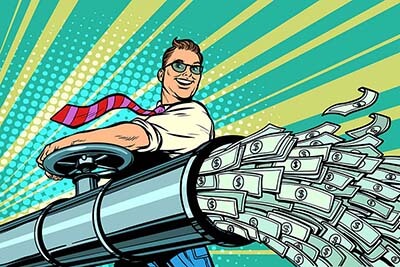
Digital art cannot be broken, fall off a wall or be destroyed in a fire since it is mostly stored online. One does not have to carry digital art around (most of the time) nor, does one need to curate it.
Since digital art has these advantages over traditional art and is developing exponentially, one may argue that it will become a completely new and perhaps a very financially feasible “product”.
Producing custom software for a project may cost anywhere between $5’000 and $20’000. Digital art itself (physical) can cost anywhere from a few USD to over $105.4 million (Andy Warhol’s “Silver Car Crash”).
Galleries specializing in digital art are opening all over the world and even though the U.S. is the leader in terms of the number of digital galleries, more and more are popping up across the globe and tickets are not cheap! Ranging from $18-$25 depending on age and the exhibition taking place (Whitney Museum), others can go for as high as $80.
Hundreds of apps and software are being developed because of high demand for self-expression and reach with the help of the internet. The tech sector is banking on this, with programs and apps ranging from $1 to about $1500.
There are many investment opportunities in the digital art industry. To this day, there are no ETFs which are focused on art, an opportunity which could be realized in the near future and which would make the art market very attractive for collectors and investors alike.
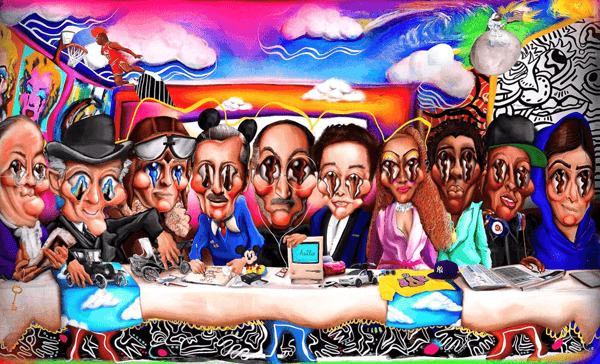 Digital art by FEWOCIOUS
Digital art by FEWOCIOUS
Sources:
nom de la video, Youtube
https://www.youtube.com/channel/UCevXpeL8cNyAnww-NqJ4m2w
https://en.bitcoinwiki.org/wiki/Anthony_Pompliano#:~:text=Anthony%20Pompliano%20was%20born%20on,Operation%20Iraqi%20Freedom%20in%202009.
https://www.creativebloq.com/news/top-10-tools-for-digital-artists-this-december
https://fineartamerica.com/art/paintings/jason+williams
https://www.google.com/search?q=how+many+platforms+do+peoeople+use+in+general&rlz=1C1GCEU_enCH910CH910&
oq=how+many+platforms+do+peoeople+use+in+general&aqs=chrome..69i57.21079j0j15&
sourceid=chrome&ie=UTF-8
https://www.google.com/search?q=podcast+statistics&rlz=1C1GCEU_enCH910CH910&oq=podcast+statis&aqs
=chrome.0.0j69i57j0l6.11533j0j15&sourceid=chrome&ie=UTF-8
https://artfundsgroup.com/stock-market-vs-art-market/
https://www.masterworks.io/
https://www.painterartist.com/en/?link=wm
https://www.digitalartsonline.co.uk/features/illustration/the-best-illustration-stories-of-2018/
https://fineartamerica.com/
https://www.wired.com/
https://www.wacom.com/en-us/products/pen-displays
https://medium.com/digital-art-weekly/18-museums-boosting-the-scene-of-digital-art-f8a4b4fa5eb9
https://visit.whitney.org/tickets/ItemList.aspx?node_id=86
https://www.etftrends.com/equity-etf-channel/is-investing-in-fine-art-a-better-option-than-bonds/
https://noow.art/





